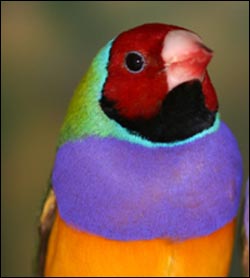If you flaunt it, you’ve got it: How red-heads top the pecking order

Copyright Sarah Pryke
Red-headed finches dominate their black-headed and yellow-headed peers by physical aggression and by the mere fact of being red-headed, according to research published today in the Proceedings of the Royal Society.
University of New South Wales biologists made the discovery following experiments with stunningly colourful Gouldian finches (Erythrura gouldiae). Among Australia’s most endangered native birds, Gouldian finches are now restricted to small isolated populations across the tropical north.
The bird has a bright green upper body, blue rump, violet-purple chest, yellow breast and bright azure-blue collar. But its most distinctive feature is its head, which occurs in one of three discrete colours: red, yellow or black. This colour polymorphism makes the Gouldian finch unique, with three distinct forms all naturally occurring and inter-breeding in the same wild populations.
The scientist’s first experiment aimed to reveal if there were behavioural differences between birds that related to the three head colours.
Observing contests between two unfamiliar males over access to food, they found that red-headed males were more aggressive and dominant than black-headed males, while both red and black-headed males dominated yellow-headed males.
In their second experiment, the scientists experimentally changed the head colours of the birds by dying them red or black to discover whether head colour was a communication “signal” between birds.
“Birds were reluctant to compete with opponents that had red dyed heads, demonstrating that they pay attention to this signal of dominance and use it to avoid getting into fights,” says one of the study’s authors, Dr Sarah Pryke, a Research Fellow in the School of Biological, Earth and Environmental Sciences.
“Red-headed birds that were temporarily dyed were still the most aggressive. This shows that red-heads are truly very aggressive and that it pays black- and yellow-headed birds to avoid fights with them.
“These findings suggest that red-heads have a dominance advantage and will out-compete the other two in contests over limited resources like food and the best nesting sites.
“As well, they show how the expression of a discrete colour is linked to a behavioural trait, and give us a new insight into how colour signals evolve as a form of communication in animals.”
Media Contact
More Information:
http://www.unsw.edu.auAll latest news from the category: Life Sciences and Chemistry
Articles and reports from the Life Sciences and chemistry area deal with applied and basic research into modern biology, chemistry and human medicine.
Valuable information can be found on a range of life sciences fields including bacteriology, biochemistry, bionics, bioinformatics, biophysics, biotechnology, genetics, geobotany, human biology, marine biology, microbiology, molecular biology, cellular biology, zoology, bioinorganic chemistry, microchemistry and environmental chemistry.
Newest articles

Silicon Carbide Innovation Alliance to drive industrial-scale semiconductor work
Known for its ability to withstand extreme environments and high voltages, silicon carbide (SiC) is a semiconducting material made up of silicon and carbon atoms arranged into crystals that is…

New SPECT/CT technique shows impressive biomarker identification
…offers increased access for prostate cancer patients. A novel SPECT/CT acquisition method can accurately detect radiopharmaceutical biodistribution in a convenient manner for prostate cancer patients, opening the door for more…

How 3D printers can give robots a soft touch
Soft skin coverings and touch sensors have emerged as a promising feature for robots that are both safer and more intuitive for human interaction, but they are expensive and difficult…





















